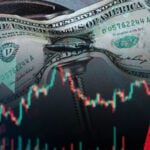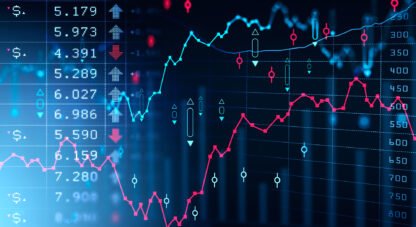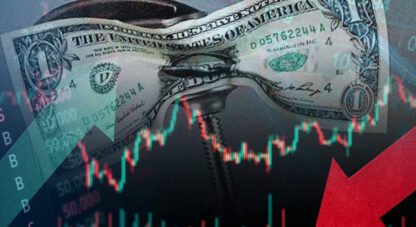Podcast: Play in new window
Prospects After a Market Melt-Up
Disclaimer: Advisory services are offered by McAlvany Wealth Management, an investment adviser registered with the U.S. Securities and Exchange Commission. The comments made in this audio recording discuss economic and market trends and are not intended as advice for any particular investor. A short selling strategy involves a substantial degree of risk. Any decision to engage in a short selling strategy should be reviewed with your financial adviser. Past performance is no guarantee of future results.
MWM Q4 2023 Tactical Short Conference Call
January 25, 2023
David McAlvany: Good afternoon. This is David McAlvany. Thanks for joining us for the call today. Fourth quarter conference call, “Prospects After a Market Melt-Up.” Doug Noland and I will cover some ground today starting with an introduction to what Tactical Short is, its performance, then market commentary, looking back and looking forward, and then we’ll come to the Q&A at the tail end. As always, if you have interest in what we’re doing and would like to engage with us as a part of your total wealth management strategy, look forward to that engagement.
We’re available for follow-up phone calls in the next few days and weeks, and would be happy to get the information to you that you need to move forward. This is an absolutely fascinating period of time to be an observer of the financial markets, and from a historical perspective there’s many parallels with things that we’ve seen in the past, and so, one of the things that will not be— There’s just no way that you could know how much time and effort goes into the management of Tactical Short, but there’s so much professional respect from my part to Doug Noland for the hours and hours and hours of reading and research and deliberation.
There’s a lot of work to be done every day, and he does a phenomenal job. So let’s get started. Again, good afternoon. We appreciate your participation in our fourth quarter 2024 recap conference call. As always, thank you to our valued account holders. We greatly value our client relationships. We do have some first time listeners on the call today, so we’ll begin with some general information for those of you who are unfamiliar with Tactical Short, and of course you can get more detailed information at mwealthm.com/tacticalshort. The objective of Tactical Short is to provide a professionally managed product that reduces the overall risk in a client’s total investment portfolio, at the same time providing downside protection in a global market backdrop with extraordinary uncertainty and extreme risk.
The strategy is designed for separately managed accounts. We did that so that it could be very investor-friendly with full transparency, with all the flexibility that you would prefer, with reasonable fees and with no lockups. We have the flexibility to short stocks and ETFs. We also plan, on occasion, to buy liquid put options. And shorting, as you well know, entails a unique set of risks, and we are set apart both by our analytical framework as well as our uncompromising focus on identifying and managing risk. The Tactical Short strategy began the quarter with a short exposure targeted at 80%, and the target has held steady throughout the quarter—was held steady throughout the quarter.
We focused on a very challenging backdrop, and in that context managing a short exposure certainly has its remarkable moments. The short was in the S&P 500 ETF, the SPY, and that remained the default position for high-risk environments.
We stress this during each call, that remaining a hundred percent short all of the time—and that’s how most short products are structured—that is risk indifference. Aggressive shorting can on occasion be very rewarding, but the market over recent years and in bouts this year—over the last 12 months—has inflicted painful losses on the short side for those who are indifferent to risk. We believe that disciplined risk management is absolutely essential for long-term success, and thus we structured Tactical Short to ensure the flexibility to navigate through even the most challenging market conditions.
I’ll give you an update on performance. Tactical Short accounts after fees returned a negative 8.29% during Q4. That’s in contrast with the S&P 500’s positive 15.3%, so for the quarter, Tactical Short accounts returned a negative 71% of the S&P’s positive return. And as for the one-year performance, Tactical Short after fees returned a negative 15.3 versus the 26.26 return for the S&P 500. So Tactical Short lost 58.3% of the S&P’s positive return. And that I hope you do reflect on. Our targeted short has varied throughout that one-year period between 75 and 80%, yet the one-year is far less than that in terms of the mirror image of the S&P’s returns, again, to Doug’s judicious rebalancing, and in where the science meets art, here you have your artist at work.
We regularly track Tactical Short performance versus three actively managed short fund competitors. The first is the Grizzly Short Fund, which returned a negative 9.44 during the quarter, and for the year a negative 18.65. Ranger Equity Bear, negative 10.3 for the quarter, negative 26.9 for the one year. And Federated Prudent Bear, a negative 7.82 for the quarter, negative 18.66 for the full year. Tactical Short outperformed the Grizzly Short Fund, the Ranger Equity Bear Fund for the quarter, while slightly lagging the Prudent Bear Fund. On average, Tactical Short outperformed by 90 basis points during the quarter. It outperformed all three funds over the past year by an average of 611 basis points.
Tactical Short has significantly outperformed each of the bear funds since inception—from April 7th, 2017, inception through the end of September, Tactical Short returned a negative 44.02 versus the 127.71% return for the S&P 500, on average outperforming our three competitors by 2554 basis points, 25.5%.
There are also the popular passive short index products. You’ve got the ProShares Short S&P 500 ETF, which returned a negative 8.62—that’s for the quarter—and negative 14.85 for the past year. And the Rydex Inverse S&P 500 returned negative 8.45 during Q4, and negative 14.55 for the full year. PIMCO StocksPLUS® Short Fund, negative 7.78, and the one-year, negative 13%.
That wraps the performance numbers, and Doug, I hand it over to you.
Doug Noland: Thanks, David. Hello, everyone. Thank you for being with us today. During the third quarter call, I stated that the environment had moved beyond extraordinary. The fourth quarter was nothing short of phenomenal. The Nasdaq-100’s 14.6% return boosted 23 returns to over 55%, the strongest since peak bubble year 1999.
The semiconductor index returned 22% during the quarter and 67% for the year. During the Q3 call’s Q&A session, I fielded a question asking why I would stick with the S&P 500 short despite the index benefiting from the magnificent seven phenomenon, and also what I look to when considering shifting to alternative short exposures. This is an important issue that I regularly address during these calls. The S&P 500 is the default position in high risk market environments and has been for me for a couple of decades. When managing short products previously, I basically had no choice but to maintain a portfolio of individual company shorts. Too often, we would be short individual company stocks when I knew the risk versus reward calculus was unfavorable. When David and I were in early discussions about developing a new short strategy, I made it clear that we needed to have the flexibility to avoid shorting company stocks when the risk was too high.
In responding to that question, I explained why I wasn’t looking to shift away from the default short exposure because short squeeze risk remained extremely high because of the proliferation of option speculation and hedging strategies created acute market risk on the short side. I believe the highly unstable market environment created elevated risk for a downside dislocation that could quickly escalate into a market crash scenario, but I also knew that current abnormal market structure remains conducive to squeezes, self-reinforcing derivative-related buying and speculative melt-up dynamics. In my response, I explained that I was operating under the assumption that we are in the transition phase between cycles, and especially tumultuous end-of-cycle dynamic for a multi-decade bull market. I was anticipating ongoing crazy, expecting the unexpected, and things definitely got pretty crazy during Q4.
I’ve been doing this for over three decades now, and I’ve never seen anything quite like it. The so-called everything squeeze—stocks, Treasurys, corporate credit, the credit default swap marketplace, global Bonds, the emerging markets, the currencies, and crypto. Virtually all markets synchronized risk-on, buying panic everywhere. Short positions across virtually all markets were crushed. Even the sickly yen rallied about 6%, with China’s vulnerable renminbi recovering almost 3%. Bearish positioning and derivatives—and certainly including the credit default swaps—were hammered across global markets.
Market hedges that had made a lot of sense in such a high-risk environment blew up in everyone’s faces. CDS prices collapsed as bank CDSs in particular sank to levels not seen since before the Fed began raising rates. The Goldman Sachs Short Index gained 16.3% during Q4, though that number doesn’t do justice. The Short Index was down almost 15% in October, with prospects for shorting appearing quite favorable. But from November 13th lows to December 27th highs, the Goldman Sachs Short Index surged 43%. This was a real backbreaker for a severely depleted short selling community fighting for survival. The popularly shorted KBW Regional Bank Index returned almost 26% during Q4, reversing virtually all banking crisis period losses. The more speculative the stock or sector, the stronger it performed. The ARK Innovation ETF returned 32% during Q4, while bitcoin’s 57% surge boosted ’23 gains to 156%.
I remember the agony all too well. Micro company short analysis appears to be working. Your short portfolio is performing well. You’re building positions, and there’s hope. And then, suddenly, it’s as if a hurricane blows through, and there’s destruction everywhere. Mid-November, Jim Chanos, the dean of short selling all the way back to the—
David: Folks, bear with me just a moment. We’ll get Doug back on here in just a second.
Doug: Yeah, I was just saying that the mauling certainly wasn’t just in the stocks, and it really was just a quarter of two distinct periods. It’s easy to forget that financial conditions were tightening in October. On October 19th, 10-year Treasury yields traded at 5% for the first time since 2007. Risk premiums were rising. High-yield CDS prices traded the highs since the March banking crisis. The market was pricing at least a 5% fed funds rate all the way out to July ’22.
But the market environment then shifted dramatically during the final week of October. A Bloomberg headline captured the change, calling it “the best run for bonds since 2020 as traders bet on Fed hike finale.” Well, Treasury yields dropped 26 basis points that week, but that was nothing compared to sinking MBS and emerging market yields. High-yield CDS prices collapsed right along with bank and emerging market CDS. There was the smaller-than-expected Treasury quarterly refunding, and a weaker non-farm payrolls report.
But the key catalyst for the reversal and squeeze was Powell’s November 1st press conference. Speaking rhetorically, the Fed chair stated in quotes, “The question we’re asking is, should we hike more?” And he repeatedly emphasized tightened financial conditions. It seems clear that Powell and the Fed were fretting ramifications of spiking yields in market instability. The S&P 500 jumped 5.9% that week, the largest gain in a year. The Goldman Sachs Short Index surged 12.9%. The regional bank index jumped to 10.7. The VIX index sank more than six points to below 15. Panic short covering and the unwind of hedges were key triggers igniting the upside market dislocation.
From there, financial conditions loosened dramatically. Heading into the Fed’s December 13th meeting, markets were already overheated. The S&P 500 was trading at a one-year high, with the Nasdaq-100 sporting a 50% year-to-date gain. The short squeeze was intense, with the Goldman Short Index up over 20% from November lows.
It is somewhat of a mystery why Powell was compelled to signal a dovish pivot at his December 13th press conference. Financial conditions had already significantly loosened. Markets were highly speculative, yet Powell was okay throwing gas on the fire. The Goldman Short Index posted a spectacular two-day 14.4% melt-up. The 10-year yield sank 30 basis points in three sessions, while the CDS price collapse accelerated.
Not only did Powell stoke a speculative bubble, he delivered his dovish pivot two days ahead of a record 5 trillion quarterly options and derivatives expiration, with derivative markets in an acutely unstable state. I don’t think fiasco is too strong. After all, Powell and the Fed were instrumental in a historic melt-up market dislocation. I won’t use our limited time to rail against the Fed, but at this stage of the cycle, and in a world fraught with risk, stoking a runaway speculative bubble was just another costly mistake.
Let’s shift directions a bit. Fed officials do hold great power to move markets, but asset inflation and speculative bubbles require monetary fuel. The Fed’s balance sheet contracted about 800 billion last year to 7.65 trillion, and is today 1.25 trillion smaller compared to its July ’22 peak. Moreover, the M2 monetary aggregate contracted 600 billion last year as bank lending slowed markedly, which begs the question: What is the monetary source fueling historic asset inflation?
I believe the answer to this question is at the heart of likely post market melt-up prospects. Was the source of the market fuel of the typical and sustainable variety, or something more threatening going on—something abnormal and prone to a destabilizing reversal? From the perspective of my analytical framework, speculative leverage is highly problematic. When a trader uses a margin loan to purchase stock, this new credit adds liquidity into the market. If large amounts of leverage and resulting liquidity enter the marketplace, this monetary fuel tends to be self-reinforcing. Inflating stock prices induce only more margin financed speculation. And as the size of this speculative credit and liquidity grow, distortions to the markets, the financial system, and the economy become more structural. From my studies of the Roaring Twenties period, I became convinced that a historic expansion of speculative leverage created vulnerabilities to crash dynamics and economic depression. The speculative melt-up that culminated in the summer of 1929 had left a fragile system acutely vulnerable to a market reversal, the self-reinforcing unwind of speculative credit, illiquidity, market dislocation, and panic.
The historical revisionists, with Ben Bernanke at the forefront, promote the view that the failure of the Fed to print sufficient money supply and recapitalize the banking system were the root causes of the Great Depression. Contemporaneous analysis appreciated that it was loose money, credit excess, faith in the Federal Reserve backstop, and rank speculation that had fueled a protracted bubble with deep structural maladjustment.
Speculative excess during our most prolonged bubble cycle has put Roaring Twenties excesses to shame. Margin lending has inflated to record levels, but in today’s world margin debt accounts for only a sliver of speculative credit, especially with the proliferation of options trading by institutions and online traders. Derivative-related leverage has surely exploded over recent years.
I suspect the magnificent seven phenomenon became a major source of late cycle speculative leverage. Call option buying in the major tech stocks and associated ETFs has been hugely market impactful, and these stocks and derivatives succumbed to speculative melt-up dynamics. Traders and derivative dealers that had sold call options and upside derivatives were forced to aggressively establish leveraged long positions in the underlying instruments to hedge their exposures. This leveraging generated powerful system liquidity expansion. But another source of leveraged speculation has likely been an even greater liquidity generator—the so-called basis trade, where hedge funds borrowed Treasury bonds while shorting corresponding Treasury futures contracts, capturing the tiny spread between the yields on the two instruments. This trade has been around for years. It had reached several hundred billion going into the pandemic. A disorderly unwind of the basis trade was a factor that forced repeated Fed announcements of larger liquidity injections necessary to quell the March 2020 panic.
The Fed’s basis trade bailout ensured that it would later inflate into one of history’s great levered speculations in the world’s most important market. Reports over the summer had the basis trade reaching 500 billion, surpassing the pre-pandemic level. By the fall, it was up to 650 billion, with reports in December of a trillion-dollar basis trade. And focus on the Treasury basis trade overlooks what is surely similar leverage in agency securities and MBS. Moreover, huge carry trade leverage has accumulated in US corporate debt, along with bond markets around the world. In the US certainly doesn’t hold a monopoly on leveraged speculation. With the Bank of Japan dragging its heels on policy normalization, a hugely advantageous yen carry trade finances massive speculative leverage in the US and globally. So when we ponder sources of liquidity fueling market melt-ups in the face of a contracting Fed balance sheet and weakened bank lending, we can safely assume trillions of speculative leveraging, margin debt, derivative-related leverage, basis trades, carry trades and such—crazy end-of-cycle monetary disorder.
Money market fund assets expanded $1.17 trillion last year, or almost 25% to a record $5.9 trillion. This crushed the $729 billion annual record set in tumultuous 2007. Moreover, 2023 was an acceleration of already historic ballooning that started pre-pandemic. Since the Fed resumed QE back in September 2019, money fund assets have ballooned $2.56 trillion, or 75%. This historic monetary inflation flies under the radar. Analysts simplistically assume growth is driven by both flight from bank deposits and general risk aversion. It goes unappreciated that the money fund complex has evolved into a critical funding source for leveraged speculation.
The Wall Street firms and major banks tap the repo market to fund their securities finance operations. When a hedge fund is levering Treasurys as part of a basis trade strategy, this borrowing is done through the repo market. And the money market fund complex has become the major source of lending into the repo marketplace.
This part of the analysis gets more complex. Back during the mortgage finance bubble period, I was focused on the money markets as the key source of financing for the ballooning GSE balance sheets. The GSEs would issue short-term debt instruments to the money funds in exchange for cash, and then use this money to buy debt securities in the open market. This new liquidity would find its way back to the money fund complex where the GSEs would simply issue more debt instruments and borrow more.
For those familiar with the workings of fractional reserve banking and the deposit multiplier, this was unfettered credit creation unconstrained by reserve requirements. I refer to this dynamic as the infinite multiplier effect. Basically, funds could be borrowed over and over again, creating the illusion of unlimited marketplace liquidity. Funding basis trade speculation with repo borrowings intermediated through the money fund complex takes mortgage finance bubble speculative leverage to dangerous new extremes.
For starters, this type of monetary inflation appears miraculous. The Treasury can run $2 trillion annual deficits while the Fed shrinks its balance sheet. Yet markets remain seductively liquid while general financial conditions loosen. The Citadel hedge fund group is a major basis trade operator. Ken Griffin, Citadel’s founder and CEO, is fond of arguing that the basis trade is lowering government borrowing costs and supporting economic growth. The problem today, as it has been for centuries, is that highly leveraged speculative bubbles neither last forever nor work in reverse. When we ponder post melt-up prospects, [unclear] to the basis trade and leverage speculation more generally are at the top of our list of considerations.
In some respects, this bubble dynamic enjoys extraordinary stability. At the heart of the financial system, the basis trade operators have full confidence that the Federal Reserve will do whatever it takes to maintain Treasury market liquidity. The Fed would, as they’ve done in the past, also move aggressively and swiftly to ensure repo market and money fund stability. And unlike risky mortgage debt, markets have no fear of credit issues, no matter the size of deficits or the ballooning size of outstanding Treasury debt.
Recalling the great American economist Hyman Minsky, stability can be destabilizing. Decades of Federal Reserve market backstops and bailouts, coins in the fuse box, have incentivized an unprecedented expansion of system leverage and speculative excess. As a student of financial history who has analyzed the mortgage finance bubble on a daily basis, I can state without a doubt that their current global bubble—the global government finance bubble—has inflated momentously beyond previous bubbles.
Fallout from the so-called great financial crisis is not yet too distant of a memory, and we know that it required trillions of Fed QE to thwart financial collapse in 2020. The next serious bout of global de-risking/de-leveraging will pose quite a challenge for the Fed and global central bank community. The bigger that bubbles inflate, the greater the amount of QE that will be necessary to stabilize market liquidity. To try to keep de-leveraging from snowballing, the Fed will surely move quickly and aggressively. And importantly, the Fed has never confronted such a policy challenge with inflation risk as elevated and the bond market as levered.
Market dynamics have been intriguing to start 2024. Opening the year to the downside, weakness in the big NASDAQ stocks seemed to spur global market liquidity concerns. Periphery markets from the emerging markets to peripheral European bonds, and US small cap stocks signal nascent de-risking de-leveraging concerns. And while the NASDAQ 100 reversed course and rallied to new all-time highs into option expiration, markets at the global periphery have been notable underperformers.
I vividly recall how big tech turned unstable to open year 2000, following 1999’s historic bubble year. There was one final big rally into quarterly options expiration, right in the face of deteriorating industry fundamentals. The March 2000 NASDAQ peak was not reached again for 15 years. I’m mindful of how a marketplace so conditioned to squeeze shorts and hedges can extend terminal phase bubble excess. As I know better than most, call the demise of a bubble at your own peril.
Meanwhile, economic data to begin the year are making the Goldilocks soft landing crowd nervous. While downshifting from Q3’s blistering 4.9% growth, a strong holiday shopping season, surging consumer confidence, and ongoing labor tightness suggest upside economic risk. Q4 GDP was reported this morning at a much stronger than expected 3.3%. After such a dramatic loosening of conditions, such data shouldn’t be surprising.
The Q4 everything rally, with market focus shifting to looming rate cuts, brought strong correlations between stocks and bonds. The rates market ended ’23 pricing at least six rate cuts this year. Last week, bonds globally came under heavy selling pressure as the market began dialing back rate cut expectations. Two-year Treasury yields jumped 24 basis points last week, while MBS yields surged 28.
At this point, ongoing big-tech bubble inflation increases the likelihood of upside surprises to both economic growth and inflation. Highly synchronized during the melt-up, bond and stock market performance could now part ways. And I see the bond market especially vulnerable in today’s post melt-up environment. Market yields and rate expectations traded to levels not supported by underlying fundamentals. And with sentiment turning so bullish, market players extended durations and let hedges expire. This heightens the risk of a surprise bout with aggressive hedging and selling with negative ramifications for marketplace liquidity.
It is today important to appreciate that melt-ups often conclude the speculative cycle. Inflated prices become unsustainable. Excesses, including speculative leveraging, turn untenable. The underlying monetary disorder becomes increasingly destabilizing for the markets as well as the real economy. That said, there is an element of George Soros’s reflexivity, where perceptions tend to shape reality. And we’ve witnessed again over recent months, news and analysis follow market direction. Surging stock prices feed bullish narratives built on soft landings, falling inflation, and rate cuts.
Analysts will boost earnings estimates, and company managements will do whatever they can to beat them. Loose conditions will ensure easy corporate borrowing and more IPOs. We see ongoing support for our thesis of a world transitioning to a new cycle. Melt-up dynamics, however, have extended the current transition phase, in the process emboldening those believing previous cycle bullish market inflation and economic dynamics will be sustained indefinitely.
The reality is one of a precarious widening gap between bullish perceptions and deteriorating prospects. This discontinuity significantly raises the odds of a disorderly adjustment, both in the markets and within the economy. Importantly, melt-up-induced price gains and liquidity excess mask mounting fragilities. Having disregarded myriad risks, markets became acutely vulnerable to abrupt reversals, de-risking/de-leveraging, illiquidity, and destabilizing shifts and market expectations.
In general, the post melt-up backdrop is one of highly elevated liquidity and de-leveraging risks. And to begin 2024, there is support for this thesis right where we would expect it to initially occur—at the vulnerable global periphery, most sensitive to waning liquidity and tightened conditions. In recent CBBs, I’ve noted the surge in global yields, especially in dollar-denominated emerging market debt. If the sophisticated global players were beginning to position for an unfolding de-leveraging dynamic, this is exactly where they would begin paring exposures. The more vulnerable currencies are underperforming. Emerging market currencies have been sold aggressively to begin the new year, while the yen has already lost four and a half percent.
It is not atypical for nascent stress at the periphery to underpin excess at the core. Even as the subprime implosion marked the beginning of the end to the mortgage finance bubble, a big rally in core AAA-rated agency and MBS securities somewhat extended the boom. These days at the troubled periphery, we have seen Chinese equities in free fall. Despite ongoing efforts to support stock prices, major Chinese indices have already suffered double-digit year-to-date declines.
Talk now is of an almost 300 billion market rescue package, a huge number that analysts view as insufficient. This is a reminder of how incredibly China’s entire system inflated during this long cycle. If 300 billion is inadequate to support stocks, how much will be required to rescue the nation’s real estate market, local government debt, the trust industry, and their almost $60 trillion banking system?
I won’t spend a lot of time on China. Despite major stimulus and a long list of policy measures, Chinese bubble deflation has accelerated. So far, the economy has been supported by ongoing double-digit credit growth, a record 5 trillion last year. But even astounding credit excess is failing to hold apartment bubble collapse at bay. Increasingly, contagion is taking hold throughout China’s bloated financial system, including local government debt, the shadow banks, the so-called small bank sector, and in corporate credit.
Talk of China exporting deflation to the world helps support the Q4 bond rally, but the world is unprepared for a crisis of confidence in China’s currency and banking system. Confidence remains high that Beijing can contain crisis dynamics. It has the international reserve assets to support its currency along with the wherewithal to recapitalize its banking system as necessary. Complacency is unjustified. The numbers, they’re just too big. 300 billion for the stock market, hundreds of billions more for the trust industry and non-banks, and literally trillions for real estate and banking system stabilization.
Meanwhile, I suspect a big chunk of China’s 3.2 trillion of international reserves is either already spoken for or less than liquid. When I ponder post melt-up prospects, I fear the world is today poorly positioned to manage through a crisis of confidence in China that would reverberate throughout global markets and economies. And as I’ve discussed in the past, I worry that worsening bubble deflation in China will trigger what I’ve called plan B. Beijing launching a strategy for Taiwan unification that would divert the Chinese people’s attention away from their government’s failings.
Especially after last Saturday’s DPP party presidential victory by an independent-minded candidate Beijing detests, I would expect China to soon begin tightening the noose. It seems reasonable that plan B would start with economic pressure, more military intimidation, threats and ultimatums, and later expand to even blockades and military actions. As recently as his New Year’s address, Xi Jinping stated that Taiwan unification is inevitable. I doubt Xi will continue to tolerate US arms transfer. And while little points to imminent military operations, with war in Eastern Europe and the Middle East, US resources are stretched.
One of history’s great bubbles is deflating in China, and there are Putin’s war on Ukraine and the expanding Middle East conflict. Then I watch US stock prices rise further into record territory. Back in the ’90s, I devoted a lot of hours studying the roaring ’20s period. I struggled with how the market, especially in the final 1928, ’29 speculative melt-up, could ignore such troubling developments both at home and abroad Over years, I’ve witnessed how bubble environments, especially during the late cycle hyper-speculative phase, ensure fixation on capturing market gains at the expense of sound analysis and evolving risks.
From my readings, it was fascinating how the so-called naysayers were completely discredited during the final roaring ’20s melt-up. And only a few short weeks prior to the great crash, Irving Fisher, the preeminent economist of that era, famously stated, “Stock prices have reached what looks like a permanently high plateau.” I’m not predicting a crash, though one wouldn’t surprise me. There are fragile market structures and potential catalysts. I do expect a problematic global de-risking/de-leveraging dynamic to be an ongoing 2024 issue.
As I mentioned, there are already signs of de-leveraging at the periphery, and resulting losses, selling pressures and liquidity challenges will likely spur contagion from the most vulnerable markets to the only somewhat less vulnerable—from the periphery to the core. US markets could benefit. They could continue to benefit from heightened stress elsewhere, but as I also discussed earlier, I believe melt-up dynamics and resulting loose conditions are problematic for the bond market. I do ponder how the basis trade will perform in an environment of fledgling global de-risking/de-leveraging.
Leveraging in cash Treasury bonds while shorting futures contracts, it’s basically free money. That is, until something upsets the apple cart, forcing the leveraged players to respond to heightened risk [unclear] market dislocation. The near market meltdown in 2020 required a massive Fed bailout. The Lehman funding crisis sparked panic de-risking/de-leveraging. And further back, I remember how the Russian currency and bond collapse sparked de-risking/de-leveraging that brought down Long-Term Capital Management and was at the cusp of unleashing market mayhem. Global speculative leverage was minuscule in 1998 compared to today.
The market is pricing 140 basis points of tightening this year. The Fed’s December dot plot was 75 basis points. There’s not much in the economic data that would suggest the need for aggressive cuts. Indeed, recent loose financial conditions and the highly speculative market backdrop beckon for tighter policy. Is the market just plain wrong? Not necessarily.
I see the rates market pricing the not-unreasonable probability of the Fed forced into aggressive loosening. A major episode of de-risking/de-leveraging would certainly provoke a response from the Fed. We can assume that risk aversion has just begun to take hold at the periphery. We’ll keep a watchful eye on signs of emerging market de-risking/de-leveraging and contagion effects. With China on crisis watch, we’ll closely monitor China’s currency and CDS prices. It’s worth noting reports of a surge in China-related derivatives trading, an important development raising the likelihood of instability and market dislocation.
And after an incredibly long delay, the Bank of Japan’s 2024 move to normalize policies comes with major risks. And we will of course closely monitor geopolitical developments. It’s not easy to imagine a global environment more fraught with risk. The trajectory of regional escalation makes direct confrontation between the US and Iran increasingly likely. The new axis of evil, Russia, Iran, North Korea, and China are poised to cause trouble in 2024. Is this the year Iran finally has a nuclear weapon? Now, with support from other axis partners, does North Korea follow in the Houthis footsteps and ratchet up misconduct? And last week Putin warned that if the current trajectory of the war continues, Ukraine’s sovereignty will be at risk.
It may be largely a stalemate on the battlefield, but Ukraine has demonstrated the ability to attack key strategic targets outside and inside Russia. Here at home, how can we feel sanguine about November? Our nation remains so deeply and bitterly divided. Most Americans are dissatisfied with a Biden/Trump rematch. And no matter the election outcome, the majority of Americans will see the winner as unfit for the presidency.
Between now and November, there are trials, appeals, and Supreme Court decisions. Moreover, either candidate could suffer a health issue that would throw the election into chaos. It’s possible that strong showings by third party candidates prevent either Trump or Biden from securing the required electoral votes. The integrity of the election results could be questioned.
I really wish I could feel better about things. I’m prepared for markets to disregard the confluence of troubling developments until they get knocked over the head by them. After the melt-up, I see markets resuming transition period dynamics. Uncertainty and indecision will surely stoke volatility. I expect the world to look differently by the end of the year. How things will progress and what to expect in Q1 is exceptionally unclear. And when I think about prospects after a melt-up, I see a world incredibly unprepared. I see our markets, Washington, and the American public woefully unprepared for a destabilizing period of historic instability. David, back to you.
David: Thanks, Doug. I just want to call attention to a couple of resources that I hope you all are taking advantage of on a routine basis. When I think of these quarterly calls for Tac Short, I think frankly there’s no better macro overview. And it’s not a stretch for me to go from the quarterly to what Doug puts up every week, the weekly Credit Bubble Bulletin. If you go to mcalvany.com and look under the Market News tab, the Credit Bubble Bulletin is there. And that’s on a weekly basis. And I think, again, no better macro overview is out there in the marketplace.
And the last thing I’ll say is that, even on a daily basis, if you look at the curation of news articles that Doug is selecting out of even the dozens of more articles that he’s looked at on a daily basis, that newsfeed is curated for you as well. And there’s no better daily resource. It saves me hours a day to start with the Credit Bubble Bulletin daily and get those curated news feeds. So do yourself a favor. If you want to continue to be at the cutting edge of market activity, market behavior, and current events, again, mcalvany.com, Market News. You can look at the Credit Bubble Bulletin daily, weekly, and then of course we’ve been doing these quarterly calls for some time now.
Reach out to us if you intend to include a separately managed account with Tactical Short as a part of your strategy. There are historic days and quarters ahead for us, and I would encourage you to go back within the next 24 hours and reread what you’ve just listened to. We have a transcript typically available within a 24-hour period, and this is a moment for you to ponder. It’s a moment for you to reflect on where we’re at and where we’re going, and the confluence of factors, whether it’s political, geopolitical, economic, or, as we’ve discussed at length today, the structures of the financial markets.
When you have these things combining, boy, a smart hedge makes a lot of sense, and I can’t think of anyone better to partner with than Doug in that respect. And again, we talked about the performance numbers earlier. Looking at our competition, it’s as if we don’t have competition because we’re doing things differently and on that basis are getting a different result. As markets move higher, obviously it doesn’t work to our favor. That’s the nature of being in a short product. But losing less is a win, and we look forward to the day that we’re winning more, and I think that day is fast approaching. So we look forward to you joining us in that endeavor, for us serving you with the skill sets that we have. And as we are transparent in the information dissemination process, as we do in these quarterly calls, I think you’ll find us to be as business partners equally open and service-oriented, so we look forward to engaging with you in that way.
And again to our existing clients, thank you so much. We appreciate your patience, your endurance, your trust and faith in the hard work that goes into this. Without further ado, let’s go to the questions that have been submitted, and we will do our best to answer those. If we miss something or there’s something you’d like to follow up on directly, a question of a more personal nature, please let us know. We’ll set up a time to visit with you in the next few days.
First question is on bitcoin, so I’ll take a stab at this one. “Will bitcoin take a bite out of gold’s performance and hold it hostage in performance?” There’s not a day that goes by I don’t get a question about bitcoin. I was asked on a television interview yesterday the same question, “What do you think of bitcoin?” And I sat there for about three seconds in silence, which on air is a virtual eternity. And I may have some blind spots here, so take what I have to say here with that in mind. But I’m still unenamored with buying a receipt for a math trend or for a math problem that’s been solved. That to me is in the category of less than interesting. But again, I have my own, we all perhaps do, but I know this is one of my blind spots.
When it comes to performance and gold and bitcoin, Arthur, you asked the question, and I think not. I think bitcoin remains an expression of speculation. And so with all the arguments of costly mining and of scarcity, and it’s the borrowed bona fides of the physical gold market, it’s still just an historically anomalous speculative instrument. It doesn’t mean people can’t make money on that. And if you look at the history of markets, there have been these speculative instruments that come. Some stay, some go away altogether. But it’s a speculative instrument, and I think gold has a different role to play. Gold shines as a non-correlated asset under a variety of stressful situations. In my view, it is the safe haven. It is the purest expression of an asset with counterparty risk, without system dependencies.
When you think of wealth preservation, when you think of insurance, there are even more benefits, but the gold holder in the midst of a pressured environment is a happy holder. And I think in that respect that the comparison between gold and bitcoin is one of apple’s and oranges. Bitcoin investors are in it for the game. It’s very different than saying, “I bought bitcoin to be a wealth preservation tool,” or, “I bought it as an insurance against counterparty risk and market volatility.” The two exist in different categories, different mandates. It’s as if we go to the racetracks. If you’re talking about a horse race, the speed around the track, that’s it, right? And bitcoin may very well win on a particular turn. But if the question is less about picking the fastest winner in the shortest period of time and instead is a question of picking the surest survivor and wealth preservation tool, then I think gold is your asset without peer.
So in terms of, again, hostage to performance, we’re really talking about an apples to apples basis for moves higher. Now, the question of how digital currencies play a role in the transformation of traditional finance, traditional banking, transaction settlement as we’ve known it in the past, I think this is a very interesting question, and there’s an opportunity there for digital currencies. There are different ways of getting things done, and no doubt we’re close to seeing a variety of technological leapfrogs.
And I’m interested in the use cases of digital currencies. I’m interested in smart contracts and the like, but these have yet to be fleshed out. I think use cases are not all that prevalent, and after 13 or 14 years of opportunity— I think of Moore’s law and how technology advances so quickly, and yet I see the idea of cryptocurrencies has been around for 14 years, but there’s been no real Moore’s law, if you will, in terms of the application, the use cases, the fundamental transitions to a new world where a digital currency is so transformative. I’m open-minded to that, and I do think that traditional finance is stubbing its toe in many respects, and there’s room for innovation and disruption. We just haven’t really seen it play out that way yet.
So, Doug, the next question is from Carl. He asks, “Is liquidity drying up? Is the liquidity in the eurodollar system that you follow and/or liquidity from other places disappearing?”
Doug: Yeah, good question. I monitor, and we discuss them at our meetings, David, I monitor a mosaic of indicators that I use to gauge marketplace liquidity and overall financial conditions. And this is various market rates and prices, risk premiums, credit spreads, credit default swap prices, swap spreads, measures of stock and bond market volatility. It is truly a mosaic. Currently here in the US, liquidity remains abundant, and financial conditions, they’re quite loose. No doubt about that. But as I just discussed, in my analytical framework, how I think about liquidity— So as long as markets are embracing risk and leverage, the marketplace will generate all the liquidity it needs and more, just through this speculative leveraging—magic, I’ll call it, of speculative leveraging. But this liquidity backdrop, it’s unstable, tenuous, unsustainable. All it takes is a shift to risk aversion and de-leveraging and we would immediately see an abrupt change in the liquidity environment. I have no doubt about that.
And that’s the problem with market and financial systems that have evolved so easily to accommodate leveraged speculation. They feed excesses and the perception of liquidity abundance, while true underlying liquidity conditions, they turn quite problematic. And as I noted, there are signs of waning liquidity at the periphery and that’s notably the emerging markets. So far, though, I see little impact on US liquidity conditions, but I’m certainly monitoring our periphery closely. High-yield bonds and mortgage-backed securities appear vulnerable to liquidity concerns, but there hasn’t been much of a movement so far in risk premium.
As far as the eurodollar marketplace, the so-called TED spread, the premium of eurodollar deposits versus Treasury bills, that used to be such a key liquidity and risk indicator, and basically no one follows it anymore because there’s been the de-emphasis of LIBOR, the London interbank lending rate. So I follow lots of these different short-term rates, and so far I haven’t seen warning signs. There was some funding tightness at the end of the year as expected, but not too much.
But so much has changed. The days when trading in New York and London dominated global liquidity dynamics, they’re long gone. These days, I look at liquidity as this global phenomenon with China, Japan, Singapore, Hong Kong, and the offshore tax havens. They all play very key roles. I think this dynamic helps to explain why global markets are so much more synchronized than they were in the past, why risk on or risk off becomes such a global dynamic. And I fear this global structure is dangerously vulnerable to one big global de-leveraging dynamic and deeply systemic liquidity issues. So we’ll monitor the situation carefully, and thank you for your question.
David: Art asks a question about gold. “The market’s projecting another up year for 2024.” I think you might mean the stock market. “Do you believe gold will hold in the 2000 plus range in 2024 or should we expect 2,500 plus?” One of the reasons why I typically take the questions on gold, Doug’s more than capable of doing so and has strong views on the value of metals in a portfolio. But as the portfolio manager for our hard asset strategies, I do look at bullion as an important liquidity management tool, and of course we have exposure to the bullion derivative products, if you will, in the form of mining shares and things of that nature. So that’s one of the reasons why I typically take the questions on gold, is it’s a part of what we do in the hard asset strategies.
Just to bear in mind, we are coming into a period of weak seasonality for gold. So barring support from an exogenous event, and gold can be very sensitive to the shocking news headline, prices could and often do soften in this timeframe, the March to June timeframe. There are exceptions to that, but if you look at most of those exceptions, again, you can tie it to acute stress, whether it’s a banking debacle or an invasion or something that will upset the seasonal trends.
We may slip below 2000 an ounce, more importantly 1975, and that certainly leaves open a trip to 1800. It would be in the works. I think below 1975, you see a quick trip to 1800. That could coincide with that seasonality. Now, past that, past that short-term seasonal weakness, if you’re looking at year-end, and to the point, where are we at the end of 2024? I think it’s quite reasonable, I don’t think it’s excessive, to see a current year price target of 2350 to 2450.
The real significance there is that we will have broken a 12-year lid at about 2100, and you begin to recalibrate the imagination of most people on Wall Street and within the investment community—the big why. Why is gold moving again, and how did it manage to break above this glass ceiling of 2100? Very significant implications for the whole space.
I think there’s three factors that could influence the price positivity this year. And so, just real quickly, why I’m not concerned at all about a trip to 1800—again, commitment of traders reports would suggest that’s likely, and of course seasonality would as well. But I’m very positive on gold and I would be buying that weakness aggressively, for these three reasons at least.
You can start with fiscal problems. Seven plus trillion dollars in US government debt being refinanced this year, with an additional two trillion in new issuance. When you let those numbers sink in and then think about the role that gold plays as an insurance, you’re talking about policies and politicians that have put us in a very awkward position from a fiscal standpoint, and at this point I think it’s reasonable to see stupidity insurance sell at premiums, and in some respects that’s what gold is. People make terrible mistakes, and you see a real-world consequence of those mistakes, and gold is just that. It’s stupidity insurance.
So fiscal problems would be number one. I think geopolitical X factors are another thing to keep in mind, and Doug covered a number of these in the earlier comments. But as with all X factors, we’re talking about unknowns, and so this is where we can look at the mix of current conflicts and discuss probabilistically which of these and to what degree they might spin out of control. But nothing’s for sure. It’s not as for sure as the math attached to our fiscal issues. But I think, again, event risk is real in 2024. And as it relates to geopolitics, that’s something you’ve got to be keeping in mind. If you are overly sanguine about growth in the equities markets, you might consider that event risk is alive and well, and can deliver a lot of damage very quickly. So whatever you’re doing to speculate for growth, you may want to hedge accordingly.
That leads me to my third factor, sell-off in equities. This is what I would categorize as a secondary decline. We saw our peaks put in in 2021, late 2021, perhaps there in the first week or two of 2022, and then of course the significant decline in equities there in 2022. But your peak valuations were there, your price-to-sales ratios of 3X, highest in all of stock market history. There you were in 2021. Valuations are not at those same peaks, but they’re marching back to them. If I’m not mistaken, I think price to sales is 2.65 today, and that in itself is far in excess of anything we’ve seen historically, with the exception of what we saw in late 2021.
So it’s the secondary declines that are particularly damaging, and that’s what I’m getting at. The first decline, 2022, if in fact we’re putting in a long-term market top, you could look at a number of analogs and say, “Dow does this behave?” People step in, buy what they consider to be value. You get a significant rally, but the fractures within the market still exist. The weaknesses are still there. And an unwind which has begun does in fact continue, perhaps characteristic of, say, what you saw in 1930, 1931, a secondary decline. The first, of course, followed by a massive rally at a 20% rally, not to new highs, but then you had the secondary decline, 1930, 1931, which was 85% from those levels, so pretty damaging.
Maybe we’ve got a different kind of decline, less outright deflationary, given the backdrop that we have today. But this is my third point, is I think you’ve got safe haven demand to the gold market in the context of an equity market decline. Consistent with Doug’s comments, there’s two parts to the fourth quarter. The first part was, you had equity analysts expecting for 2024 to be mostly negative, and then of course the market melts up the end of Q4, late November, through the end of the year. And now all of a sudden analysts have shifted uniformly to the other side of the boat, uniformly bullish. Yardeni posted a 5,400 S&P 500 projection for the year. He’s one of a dozen that I can think of. The uniformity, I think, is worth noting. I grew up in a household with a dad who was, I think, by nature contrarian, and I always heard the majority is always wrong. So when I see uniformity, I am somewhat suspicious that everyone is right at the same time.
2024 might be a year of disappointment for your equity bulls, and granted, we’ve got the melt-up in motion, so to some degree it’s a question of rocket fuel. Perhaps there’s enough to maintain this trajectory. For the time being, it is going higher. But should equities slip, as I mentioned, that’s the third factor. That’s the third factor which could push gold higher. The other two are very, very real as well.
Doug, we were just talking about inflation, deflation in the 1930s. There’s another question I’m going to skip down to because I think you could add some meat to this. “Given the current debt position held by the US, interest payments on debt being higher than the total military spending, do you foresee a deflationary dip prior to a highly inflationary decade for the rest of the 2020s? If not, what type of monetary and fiscal environment do you project for the remainder of the 2020s?” Got an idea or two, but I’d love to hear your thoughts.
Doug: Sure. Yeah. With my focus on this potential for a global market accident—we’ll call it a big deleveraging event—that would certainly spur a lot of deflationary fears. But at the same time, I expect a very swift and massive policy response, surely in the trillions. So it could be a temporary deflationary episode followed by a powerful response. Also, I think a period of acute financial instability might finally spur a flight into hard assets, and there would be inflationary consequences there.
For the remainder of the 2020s, I think a safe bet is massive federal deficits as far as the eye can see, or at least until the bond market forces some fiscal discipline in Washington. I think that’s going to happen at some point, but I guess seeing is believing. And I think the Fed is trapped here as the so-called buyer of last resort, the liquidity provider for this runaway bubble that’s going to require a lot of QE. So yeah, I see a lot more QE. I see a balance sheet, the Fed’s balance sheet. I would not be surprised if the Fed’s balance sheet goes 15, 20 trillion by the end of the decade, doubles again.
And I see this as an unfolding new cycle, and we’re just going to see ongoing heightened political and inflation risk. I don’t think it’s going away. I think we could see some deflation, but the overwhelming policy bias here is inflationary, and at the minimum we’re going to see just monetary disorder. We could see all kinds of price movement. We could see asset prices, financial asset prices, under pressure while prices of real things decline. I think this geopolitical backdrop, I think we should be prepared for supply shocks, and all of that kind of thing. Supply chain issues, inflationary pressures there. So, I’m not expecting a smooth price environment for the rest of this decade, that’s for sure. And I’ll let you speak more eloquently, David.
David: No, I think inflation is a policy choice, and we tend to see it as an economic problem to be solved, and we’re hoping that policymakers are implementing things that solve the problem, and that misses the point. It misses the point that inflation is a policy choice. Now, granted, you don’t want excess inflation, you don’t want too much, but when you’ve got $34 trillion in debt, and that’s compounding at an aggressive rate, there is such thing as too little. If there’s too much inflation, there’s also too little. And so deflation is for policymakers like staring into an abyss from which you may never emerge. And that’s where I think, if you are looking at the fiscal picture that we have, you are talking about the necessity of QE in the context of market chaos or what have you.
But we don’t have a way out of inflation otherwise. The loss of reputation, the hit to reputation, if we were to outright default on our liabilities—not going to happen. Certainly that’s not a first choice. So, if it does happen, you know how desperate things have gotten. So, given that a formal default is a lower probability, I think the informal default— Policymakers will lean on inflation as a policy. To quote Keynes, “It’s a policy that not one in a million understands.” So, yeah, I think, Doug, we’re on the same page. A deflationary dip in asset prices is another matter altogether, but in terms of the policy response, and what’s going to be served up and forced on us, yeah, there’s a lot more of an inflationary prospect over the next decade.
I’m going to jump on this one question that’s kind of politics, and hopefully I don’t step my foot in a bear trap here. “What are the political consequences of the presidential election, and how is Wall Street playing that?”
I have strong political views. We try to set them aside as much as possible when we’re looking at the markets just to see what the impact is of cause and effect. And maybe when I was talking about gold and the three factors that could push gold higher, perhaps I should have included political dysfunction as a fourth reason to own ample ounces—ample ounces of private and portable wealth. And if you think about that political dysfunction, is there a priority on having a part of your wealth that is private and portable? Yes, I think so. I think we need to see who gets the nominations first. I mean, there’s a lot of complications here that really things haven’t been fleshed out. Biden’s fragile, there’s a good chance he’s not on the ballot. The DNC is reasonably concerned he can’t win against Trump.
There’s those kinds of undetermined factors. We could see some last minute things that become either compelling or completely repulsive. Who are the vice presidential choices of each of the presidential candidates? We’re talking about two elder statesmen. I can use air quotes on that last part, I think. And the vice president may very well be the person we’re electing as president. We don’t really know who those people are, or how Wall Street will play it. That’ll happen quickly once we’ve got those facts. This is an election for the history books, and this doesn’t sound too sour, but I’m hoping it’s not the last chapter. Doug, the next question I’ll shift to you. “How will the Fed lowering the interest rate affect the Tactical Short fund?”
Doug: Okay, so of course a lot depends on the circumstances around the Fed cutting rates. We’re always mindful—we have to be mindful—of any loosening of monetary policy. No doubt about that. But that’s rate cuts, and more likely—probably a bigger concern—would be Fed balance sheet operations. But Fed policy is currently not dictating overall financial conditions. The Fed raised rates five percentage points and reduced its balance sheet by more than a trillion, yet financial conditions are today arguably looser than when they started their so-called tightening cycle. And the market’s already priced in five rate cuts or so. So, a typical 25 basis point rate cut, at this point, wouldn’t be very market impactful. Market’s already discounted. Financial conditions are already loose. It’s the unexpected policy easing that creates the most challenge for managing short exposure because we see the Fed as having no alternative at this stage of the cycle than to employ aggressive easing policy to hold crises at bay.
This is an important aspect of why we say this is a highly elevated environment for shorting, and it’s going to remain highly elevated for a while because we’re expecting the Fed to respond to any market dysfunction. If I were forced to make a prediction, I would expect Federal Reserve rate cuts to be in response to tightening of financial and market liquidity conditions. The Fed will cut aggressively because of the counter de-risking/de-leveraging. And it’s this scenario that creates such an elevated risk of ongoing short squeezes and abrupt derivative related dislocation. So, we’re always focused on that.
So, when we decide how to allocate our short exposure, we take these into consideration. In the past, I’ve used options to help mitigate risk in really high-risk environments, and this is something that we will consider. That could be puts. It could also be potentially even market calls to hedge against an abrupt rally in the market. So, there’s different things that we can do. If we start to see financial conditions tighten, we want to be more opportunistic, but we also know there’s the risk of a Fed response.
So, aggressive rate cuts would likely come concurrently with more QE. My view, the Fed’s balance sheet, it’s going to get a lot bigger to accommodate the next bout of serious market de-risking/de-leveraging—I just threw out the numbers, 15, 20 trillion.
In a higher inflation environment, another big round of QE could prove highly destabilizing. And one of these days, the bond market might not respond well to inflationary policymaking, and that would be a major development. I mention this because I expect the analysis around the next Fed easing cycle, it’s going to be really challenging, and quite important with respect to how we position Tactical Short, focus on potential policy measures, financial conditions, market, the whole thing. It goes way beyond just a simple Fed rate cut. We will be working hard to stay on top of developments, and thank you for the question.
David: Doug, sometimes I hear what you’re saying, and I think what’s missing here is the reality of conflict, and what I’m thinking of is Patton was a general who was made for war, and I see you as someone who, in the financial markets, is, I mean, you are geared for the trenches. You are geared for the kind of conflict which to most people is harrowing, and people don’t know what to do with. And there’s a lot of days in the market where you don’t need someone who’s practiced in the trenches, and who’s made for war, but the day that we’re there is the day that you are going to be appreciated as a Patton.
And I don’t know why I feel like I need to say that, but there’s long stretches where the market just could care less about hedging—because who needs it? It’s blue skies, right? And who needs a Doug Noland if the stock market’s going to triple in value from here to three years from now? That’s kind of the attitude, and I think we’re fast approaching that period of conflict where you’re absolutely in your element, and the lessons of the last 30 years get played out on a daily basis, and the disciplines that have been practiced for so long are of such great value to our existing account holders, and to many new account holders as well. Sorry, that’s a little off-topic.
Doug: No, well thanks David. I will throw out— The challenge on the short side, and why most people don’t want to do it, they’re not built for it, whatever— You have to come in every day, you have to be willing to be very patient, and I mean patient in years, so you have to be patient, you have to stay focused on risk disciplines, but you also have to come in every day watching very closely for things to change. You can’t just sit back, and you have to come in every day even though you’re patient, even though the market’s been going against you, because you have to be ready to move. And that’s the challenge, and maybe that’s my strength. I don’t know. I hope so, but thank you.
David: Next question, Kyle asks, “With the S&P hitting all time highs, what does this mean for the everything bubble we’ve heard Doug talk about in the past? Do you anticipate manipulation from the presidential election cycle to continue to buoy equities?” I’ll give a quick comment on this.
I think, of course, in one respect. Maybe I should ask it a little differently, or frame the question a little differently. Have you ever seen fiscal conservatism in an election year? And I’m focusing on fiscal, but I’m not really talking about the rhetoric. You can have politicians who give lip service to fiscal conservatism, but this is the time. This is when you goose everything you can. Goose the economy, buy votes, promise them. I mean, this is a bipartisan competition for power, and promising money that you don’t have, I mean, this is the game. I’m not as convinced, I’m not as convinced that we will see a broad-based market manipulation.
To be clear, there can be short-term interventions and manipulations in the financial markets. You look at thinly traded timeframes, you look at strange aberrations as you come into options expirations, and you can tell there is an expression of interest, and a forcing of hands, but we’re in a bit of a different place. We’re in a blow-off stage in the financial markets where manipulation is less of a concern than mood moving to the mode of irrational exuberance, and we’re there. We’ve clearly gotten there with the Mag Seven, and so it’s difficult to say, “Well, it’s all politics here. If the stock market goes higher this year, it’s because the current administration wants it so, and they’re pulling all the strings.” I don’t know. I mean, they’re not making people do stupid things. Who in their right minds pays today for 80 times of income? Welcome to the most popular stock on the market today, Nvidia as a market cap that exceeds the entire S&P energy sector.
Think about that. Just one company out of that energy sector, ExxonMobil—a fraction, a fraction of Nvidia’s market cap, but has 10 times the revenue. This is not manipulation, this is poor judgment. This is where you see a passion on display for rewards without regard for risk. And so anything can happen between here and November. You’ve got the melt-up that can continue. You’ve got the fiscal trend—if we can buy votes, we will. Great. Nothing new there, seen it before. Both sides of the aisle love doing it.
What we don’t know is if that sort of irrational exuberance continues through November, because then all of a sudden, if it does turn, it’s consequential. I mean, maybe politically consequential, but certainly for the net worth of the American family it’s consequential as well.
Let’s see. I don’t know if I answered that question or not, but moving on to one for you, Doug. “What’s going to break this market? How soon? What’s going to cause it? How certain are you? Any way beside the Tactical Short that’s not too technical to profit from it? Thanks, Bob.”
Doug, I think you’re muted.
Doug: Terminal phase excess. Things really go haywire at the end of cycles, and excess, they basically create their own demise. Nasdaq right now is in this melt-up that will become increasingly difficult to sustain. I tend to think a surprise jump in bond yields could be a catalyst to a bursting equities bubble. The bond market could be hit by strong growth or resurgent inflation. The Fed could be forced to turn more hawkish, and even resume rate hikes. I know that sounds crazy, but I don’t think it’s that crazy of an idea. I discussed the risky geopolitical backdrop in my earlier discussion, and expanding Middle East war, direct conflict with Iran is a possibility. Hostility in the Straits of Hormuz, could see a problematic spike in energy prices.
Does a country present a serious nuclear threat? And that’s Iran, North Korea, or even Russia? There are a number of potential geopolitical catalysts, and there are a bunch out there that would completely surprise us, I’m sure. The backdrop is especially uncertain. I can only do my best to gauge probabilities for different scenarios. I’m 100% convinced—and that’s always dangerous saying that, but I believe it—I’m 100% convinced the current environment is an unsustainable bubble. I have no doubt in the bubble analysis, but I have little clarity on when, and exactly what will pierce this bubble. As for trying to profit from a market break, with Tactical Short we employ a disciplined approach to provide a hedge for what is today highly elevated market risk. We’re trying to provide a reliable hedge there. We don’t recommend speculating against the market, as David mentioned earlier. We don’t want people going out and making big bets against the market. I warn individual investors against shorting stocks on their own, and options trading is quite— It’s challenging even for those of us experienced in trading options.
David’s mentioned this: we like gold and precious metals and other hard assets as long-term hedges against inflationary policymaking and financial asset instability. I’ve said this in the past, but in general, for me, when we see storm clouds on the horizon, it’s a smart strategy to save as much as we can, pay down debt, get hunkered down. We can’t go wrong there, can we? But thank you for your question.
David: Yeah, I’ve got another question here. I’ll address it. “What will be the federal government response when they realize QE is making things worse for the voter, not better? Doubtful they would just do nothing and let things play out naturally. Will they work to get their fiscal house in order, declare bankruptcy, or not pay their debt and start over?”
This is to David who asked the question: Unfortunately, I think looking at past periods of market crisis, we see the government doing more of the same. And I think you can include the central bank in this, too. There’s not typically a lot of objective, or honest, reflection. More common is a new policy suite, and it’s based on misattribution of past problems and causes, and a reintroduction of the same stuff with just a different acronym attached to it. So, this idea that maybe they’ll recognize that it was a bad idea—
We never heard Robert Rubin with a mea culpa for opening up the securitization Pandora’s box back in ’99. We never heard Alan Greenspan acknowledge that pouring gasoline on a speculative inferno—that he was in part responsible for upping the temperature, because in part these are guys who pat themselves on the back for their procyclical policies— This idea that a little is good, a lot is better. That’s how people feel about growth. If a little is good, a lot is better, and that’s what we helped do even though our policies were procyclical. Yeah, but it was helping everyone become wealthier. QE is just not a problem, in their view. Again, I would maybe disagree with the basis of the question, are they going to realize that it’s made things worse? No. I think they’ve looked at what they’ve done, and they said, “Look, we were in radical circumstances, we took radical measures. The world did not come to an end.” And I just don’t see a lot of self-critique.
QE is one of the tools that they will want to use again. It’s going to be taken from the toolkit again. They’re going to look at it, and say, “No. Our perspective on how things unfolded is, we won. The world came to a brink of disaster, whether it’s a global financial crisis, or what have you, and we won.” Getting a fiscal house in order, another part of your question, David. I think the way they do that going forward is by assigning losses in the way that’s most politically expedient and publicly opaque. And there, I think inflation is the policy tool of choice.
Maybe what we misinterpreted a year or so ago when they started talking about higher for longer— We thought they were talking about rates. Maybe that was just commentary on inflation rates, not interest rates. I think there’s too much institutional hubris for there to be a confession of mistakes in the past, and frankly too much blindness created by a view of money and credit that they hold to be as liberating instead of something that is ultimately enslaving and debilitating, or destabilizing to the system.
So, you are talking about a worldview conflict where two people look at one thing, and see something radically different. David, you think they should be recanting. You think that they should be doing something different, and they’re saying, “We did exactly what we were supposed to do, and it worked.” I kid you not. I kid you not. There is that institutional hubris.
So, as we wrap up, I just want to again reiterate our gratitude for the clients that we work with in Tactical Short. And for those of you who are considering working with us, we look forward to it. Let’s get on the phone, let’s put something on the schedule in the next couple of days and map out how this fits, what you need to hedge in the most effective way to use Tactical Short as an arrow in the quiver. It’s not a solution for all things. It’s not intended to be. It’s meant to be something that reduces the total volatility in your investment portfolios, and it does that very effectively in a down market. We look forward to introducing that as a layer into your financial picture. Be in touch with us. We look forward to it. And thank you so much for your time today. Doug, any last comments?
Doug: Yeah, thanks, everyone, for being on the call. Apologies for the technology glitch, and good luck out there. Take care.
David: Thanks. Have a great day.















